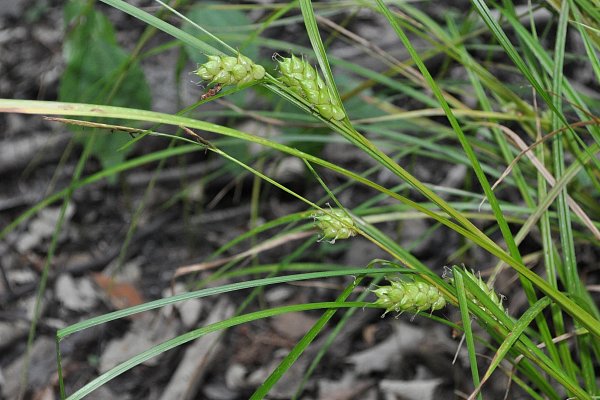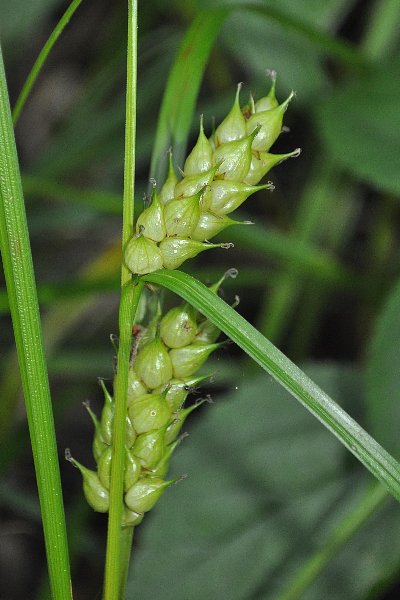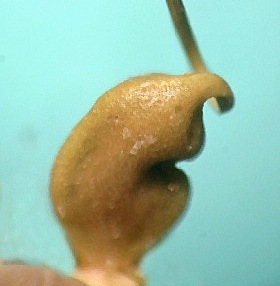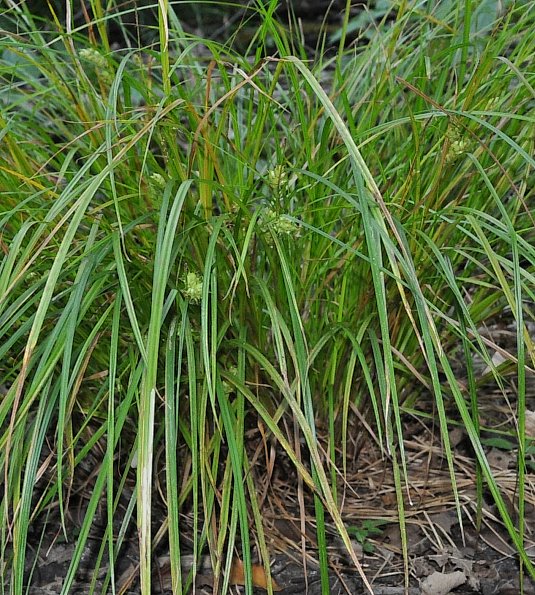
Individual perigynia (sac-like structures surrounding the achenes) are 7-10.5 mm. long and 4.5-6.5 mm. across; they are ovoid in shape, abruptly tapering into elongated beaks. Individual perigynia have several prominent longitudinal veins and they are glabrous, varying in color from light green (while immature) to brown (when mature). The pistillate scales are about one-half to two-thirds the length of the perigynia; they are lanceolate with acute tips, green-veined in the middle, and membranous along their margins (while immature). At the bases of spikelets, there are leafy bracts, some of which may overtop the inflorescence. These bracts become substantially smaller as they ascend the inflorescence. The blooming period for this sedge occurs from late spring to mid-summer, lasting about 1-2 weeks. The florets of the spikelets are cross-pollinated by the wind. At maturity, the disarticulated perigynia can float on water, distributing the achenes to new locations. Mature achenes are 3-4 mm. long and 2-2.5 mm. across; they are bluntly 3-angled, glabrous, and deeply indented along one side. The root system is fibrous and short-rhizomatous.

Cultivation: The preference is partial sun, wet to moist conditions, and relatively loose soil containing loam and decaying organic material. This sedge tolerates standing water if it is temporary.
Range & Habitat: The native Tuckerman's Sedge occurs primarily in NE Illinois and one or two other areas in the northern half of the state (see Distribution Map); this sedge is rare and state-listed as 'endangered.' Illinois lies along the SW range limit of this species. Habitats include depressions in upland savannas, floodplain and bottomland woodlands, swamps, edges of vernal pools and streams in wooded areas, soggy woodland openings, and sedge meadows. This sedge is typically found in high quality wetlands that are shaded or semi-shaded.

Faunal Associations: Sedges (Carex spp.) in wetlands and woodlands provide sources of food and cover for a variety of invertebrate and vertebrate animals. Among insects, the foliage, seeds, and plant juices of sedges are fed upon by leaf beetles (Plateumaris spp.), the Sedge Billbug (Sphenophorus costicollis), seed bugs, plant bugs, a shield bug (Eurygaster alternata), aphids, leafhoppers, stem-boring larvae of various flies, sedge grasshoppers (Stethophyma spp.), caterpillars of skippers, caterpillars of moths, and caterpillars of two butterflies, the Eyed Brown (Satyrodes eurydice) and Appalachian Brown (Satyrodes appalachia); see the Insect Table for more information. The seeds or spikelets of sedges are eaten by various wetland birds, including ducks and rails (see the Bird Table for more information). Either the spikelets or foliage are eaten to a limited extent by some turtles, including the Snapping Turtle (Chelydra serpentina) and Eastern Mud Turtle (Kinosternum subrubrum). Among mammals, muskrats occasionally feed on the stems, roots, or young sprouts of sedges, while deer feed on the foliage sparingly.

Photographic Location: Along a wet depression in a woodland of NE Illinois. The photographs of the spikelets and foliage are Copyrighted © 2012 by Lisa Culp, while the photograph of the achene is Copyrighted © 2017 by Linda Curtis.
Comments: The most unusual characteristic of this sedge is the deep indentation on one side of its achenes. Other similar species of sedges (Carex spp.) have achenes without such indentations or (less often) they have only shallow indentations. Otherwise, Tuckerman's Sedge resembles several other wetland sedges that are found in either wooded or open areas. It has relatively narrow leaf blades (3-5 mm. across) and its inflated perigynia are relatively large in size (7-10.5 mm. in length).